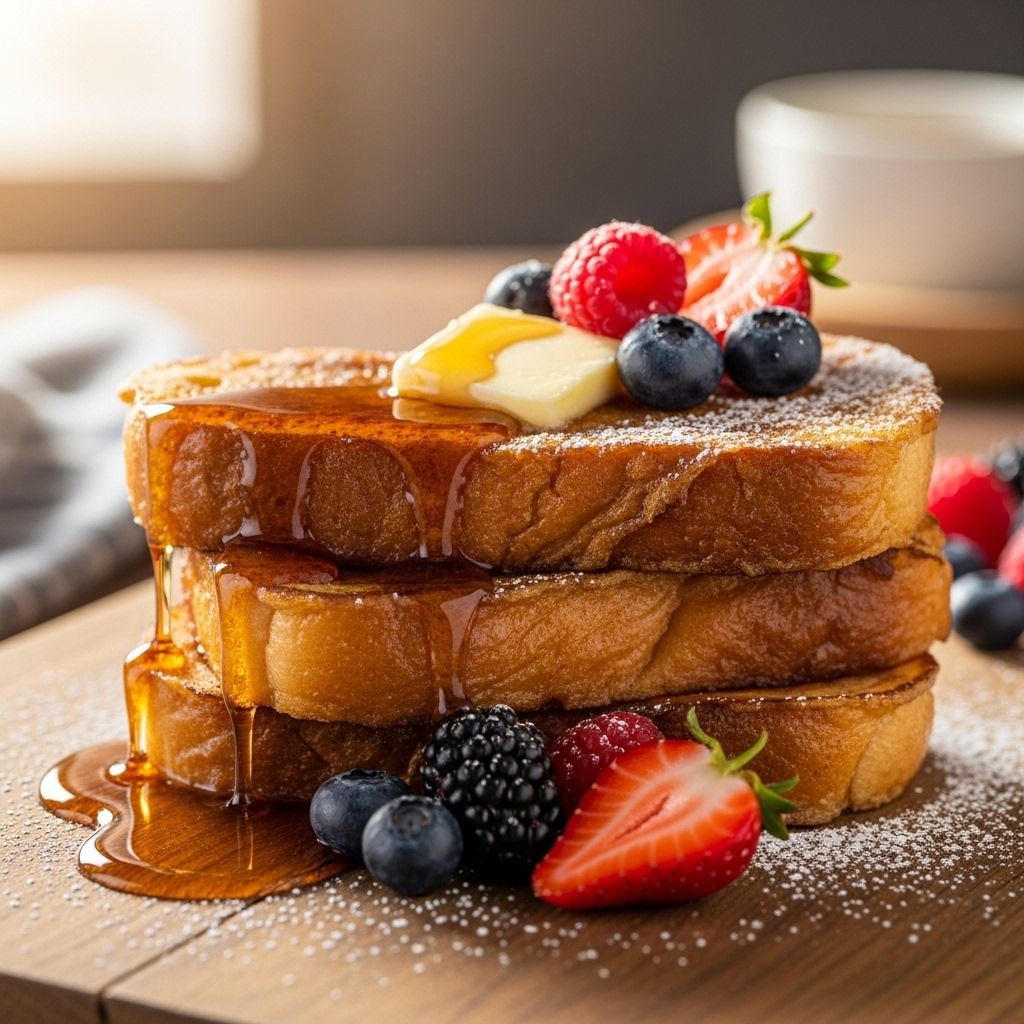The Science and Art of Perfect, Quick, and Easy French Toast
Expert tips and kitchen hacks ensure a tender, caramelized result that delights the senses.

The Art of Perfect French Toast
Few breakfast classics evoke as much nostalgia and warmth as French toast. Combining simple ingredients—bread, eggs, milk—and a splash of culinary magic, French toast transforms the ordinary into the extraordinary. The key to perfection lies in balancing texture and flavor: an exterior that’s crisp and caramelized entwined with a soft, custardy core. This article will guide you through the science, techniques, and recipes behind perfect, quick, and easy French toast, ensuring every batch is a triumph.
What Makes French Toast Perfect?
A truly exceptional French toast features:
- Golden, caramelized exterior: Achieved by proper cooking and sugar interaction.
- Creamy, custardy center: Bread soaks up the egg-milk mixture without becoming soggy.
- Balanced sweetness and spice: Cinnamon, vanilla, and a touch of sugar elevate the dish.
- Adaptability: Works with a range of breads and toppings.
As described by expert cooks, high-heat caramelization lends French toast a crème brûlée-like crunch, while the inside remains tender and flavorful.
A Brief History
Although commonly associated with French cuisine under the name pain perdu (“lost bread”), French toast appears in culinary traditions around the world. Its roots stretch back to ingenious cooks making use of stale bread by soaking it in milk and eggs, then frying it to produce a nourishing meal.
Modern French toast honors both tradition and innovation, adding touches like cinnamon, vanilla, and fruit toppings.
Choosing the Best Ingredients
The selection of ingredients determines the taste, texture, and appeal of French toast. Here’s what you need:
- Bread:
- Thick, sturdy slices (e.g., brioche, challah, Texas toast) absorb custard without disintegrating.
- Day-old or slightly stale bread works well, preventing sogginess.
- Avoid thin sandwich bread, which can become mushy.
- Eggs: Provide richness and structure; use fresh, large eggs for best results.
- Milk or Cream: Whole milk yields a creamy texture. For extra luxury, substitute part of the milk with heavy cream.
- Sugar: Just enough for subtle sweetness and caramelization.
- Spices & Flavorings: Cinnamon, nutmeg, vanilla extract, and a touch of salt add depth.
Quick and Easy French Toast Recipe
This recipe balances speed and excellence, making breakfast both efficient and delectable.
| Ingredient | Measurement |
|---|---|
| Bread (thick slices) | 4 slices |
| Eggs | 2 large |
| Whole Milk | 1/2 cup |
| Sugar | 2 tbsp |
| Cinnamon | 1/2 tsp |
| Vanilla Extract | 1 tsp |
| Salt | 1/4 tsp |
| Butter (for frying) | 2 tbsp |
Step-by-Step Instructions
- Prepare the custard:
- In a shallow dish, whisk eggs, milk, sugar, cinnamon, vanilla, and salt until homogeneous.
- Soak the bread:
- Lay bread slices in the custard, allowing each side to soak for 15–30 seconds, depending on thickness and density.
- Fry to perfection:
- Heat butter in a nonstick or cast iron skillet over medium heat.
- Add bread slices and cook until deep golden and crisp, 2–3 minutes per side.
- The sugar caramelizes, creating a crisp outer shell reminiscent of crème brûlée.
- Serve immediately: Top with syrup, powdered sugar, fresh fruit, or your favorite adornments.
The Science Behind Custardy French Toast
What distinguishes superior French toast is the kitchen chemistry at work:
- Maillard Reaction: The interaction between sugars and amino acids when exposed to heat produces savory, toasted flavors and aromas.
- Caramelization: Sugar in the custard and exterior caramelizes during frying or baking, creating a crunchy shell akin to dessert French toast.
- Custard absorption: Optimal bread structure lets the custard infiltrate without oversaturation, yielding a creamy yet firm bite.
Careful control over heat and timing prevents burning and guarantees the right texture.
Best Bread for French Toast: Comparison Table
| Bread Type | Texture | Custard Absorption | Flavor Profile |
|---|---|---|---|
| Brioche | Soft, rich | High; retains shape | Sweet, buttery |
| Challah | Slightly dense | Excellent | Mild, eggy |
| Texas Toast | Thick, fluffy | High | Neutral |
| Sourdough | Chewy | Moderate | Tangy |
Advanced Techniques and Pro Tips
- Stale bread is best: Day-old bread absorbs custard efficiently without becoming gooey.
- Don’t over-soak: Depending on the bread, adjust soak time for best texture.
- Temp matters: Medium heat prevents burning the outside before the inside cooks.
- Butter, not oil: Butter in the pan enhances browning; clarifying butter can reduce burning risk.
- Sugar crust: Sprinkling a mixture of sugar and cinnamon on pre-soaked slices creates a caramelized layer.
- Oven finish: For extra crunch and uniformity, bake briefly after pan-frying.
French Toast Variations and Customizations
French toast lends itself to countless modifications. Here are some popular customizations:
- Stuffed French Toast: Layer with cream cheese, fruit preserves, or chocolate before frying.
- Savory French Toast: Omit sugar, add grated cheese and herbs to the custard, and serve with fried eggs or avocado.
- Baked French Toast: Arrange soaked slices in a buttered baking dish, sprinkle with cinnamon sugar, then bake, flipping once halfway.
- Vegan French Toast: Substitute plant-based milk and a flaxseed egg for dairy and eggs.
Top Toppings and Sauces for French Toast
- Classic: Maple syrup, powdered sugar, and fresh berries.
- Richer: Chocolate ganache, whipped cream, caramel sauce.
- Fruit-forward: Sautéed apples, bananas foster, marmalade.
- Nuts & Crunch: Toasted pecans, almonds, granola.
Troubleshooting: Common French Toast Mistakes
- Soggy French toast: Often due to over-soaked bread or inadequate browning. Use sturdy bread and medium heat.
- Bland flavor: Insufficient sugar, salt, or spice. Taste custard mixture before soaking bread.
- Burnt exterior: Pan too hot or too much sugar. Moderate heat and distribute sugar evenly.
- Dry inside: Thin slices need less cooking time; avoid pressing down on bread while frying.
Frequently Asked Questions (FAQs)
Q: Can I use any bread for French toast?
A: Most breads work, but thick, hearty slices (brioche, challah, Texas toast) deliver the best custardy results. Stale bread is even better.
Q: What’s the secret to French toast that’s crispy outside and custardy inside?
A: Proper bread selection, the right balance of custard ingredients, and enough frying time to caramelize sugars are critical for texture.
Q: How can I make French toast ahead of time?
A: Prepare and soak the bread the night before, keep refrigerated, and fry just before serving. Alternatively, baked French toast can be assembled and baked the next morning.
Q: Is French toast sweet or savory?
A: It can be either. Classic recipes are sweet, but savory versions work well for brunch with herbs and cheese.
Q: Can I freeze leftovers?
A: Yes. Cool completely, layer between parchment, and freeze. Reheat gently in a toaster oven or skillet.
Expert Insights and Final Tips
- Experiment: Adjust spices and custard ratios to suit your taste.
- Don’t rush: Let bread soak properly for full flavor and texture.
- Finish in oven: After pan-frying, a short bake ensures heat reaches the center, finishing the custard without drying it out.
- Embrace caramelization: The crunchy, sweet crust is what transforms French toast from breakfast staple to impressive treat.
Summary
French toast embodies comfort, versatility, and culinary heritage. By selecting the right ingredients, mastering the soaking and cooking techniques, and customizing toppings, you can create an unforgettable breakfast dish. Whether you prefer classic flavors or crave inventive adaptations, this guide equips you to make quick, easy, and perfect French toast whenever inspiration strikes. Happy cooking!
References
Read full bio of Srija Burman












